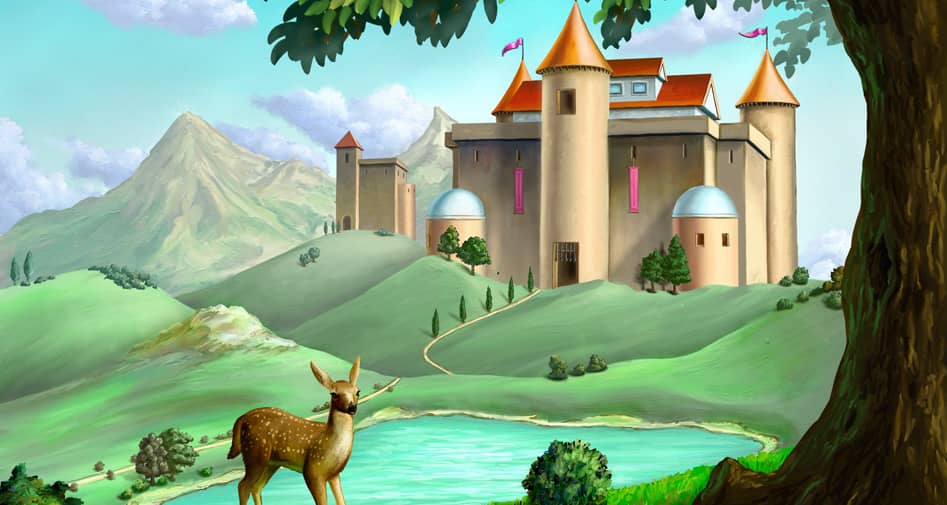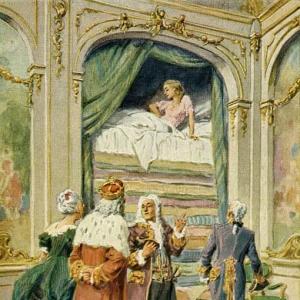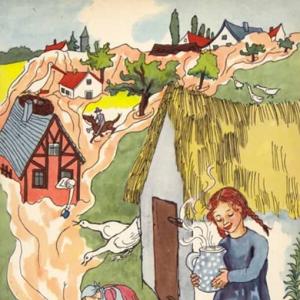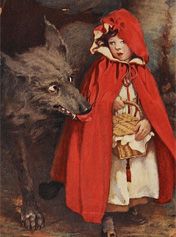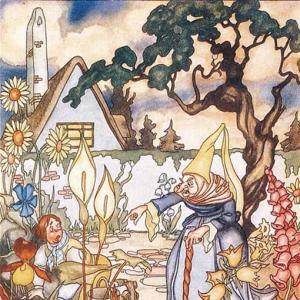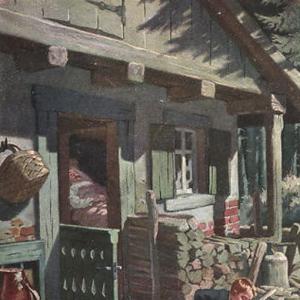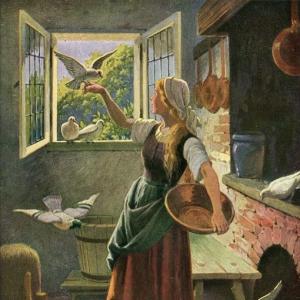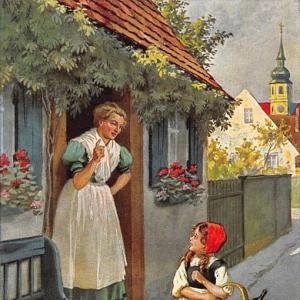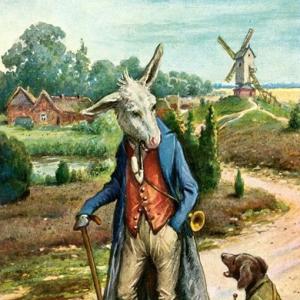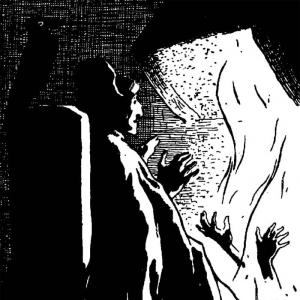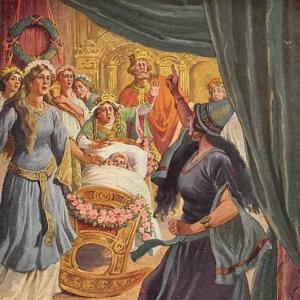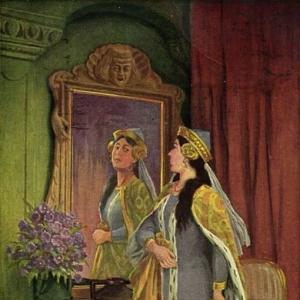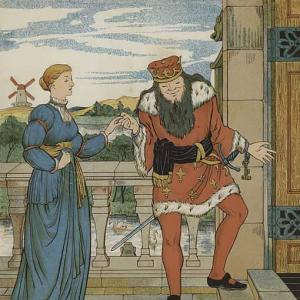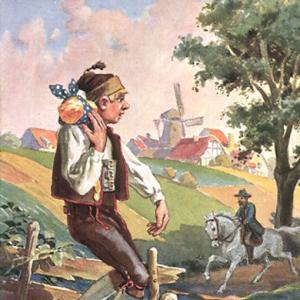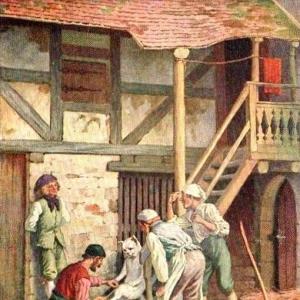Reading time for children: 18 min
There was once a girl who trod on a loaf to avoid soiling her shoes, and the misfortunes that happened to her in consequence are well known. Her name was Inge. She was a poor child, but proud and presuming, and with a bad and cruel disposition. When quite a little child she would delight in catching flies, and tearing off their wings, so as to make creeping things of them. When older, she would take cockchafers and beetles, and stick pins through them. Then she pushed a green leaf, or a little scrap of paper towards their feet, and when the poor creatures would seize it and hold it fast, and turn over and over in their struggles to get free from the pin, she would say, „The cockchafer is reading. See how he turns over the leaf.“ She grew worse instead of better with years, and, unfortunately, she was pretty, which caused her to be excused, when she should have been sharply reproved.
„Your headstrong will requires severity to conquer it,“ her mother often said to her. „As a little child you used to trample on my apron, but one day I fear you will trample on my heart.“ And, alas! this fear was realized.
Inge was taken to the house of some rich people, who lived at a distance, and who treated her as their own child, and dressed her so fine that her pride and arrogance increased.
When she had been there about a year, her patroness said to her, „You ought to go, for once, and see your parents, Inge.“
So Inge started to go and visit her parents; but she only wanted to show herself in her native place, that the people might see how fine she was. She reached the entrance of the village, and saw the young laboring men and maidens standing together chatting, and her own mother amongst them. Inge’s mother was sitting on a stone to rest, with a fagot of sticks lying before her, which she had picked up in the wood. Then Inge turned back. She who was so finely dressed she felt ashamed of her mother, a poorly clad woman, who picked up wood in the forest. She did not turn back out of pity for her mother’s poverty, but from pride.
Another half-year went by, and her mistress said, „you ought to go home again, and visit your parents, Inge, and I will give you a large wheaten loaf to take to them, they will be glad to see you, I am sure.“
So Inge put on her best clothes, and her new shoes, drew her dress up around her, and set out, stepping very carefully, that she might be clean and neat about the feet, and there was nothing wrong in doing so. But when she came to the place where the footpath led across the moor, she found small pools of water, and a great deal of mud, so she threw the loaf into the mud, and trod upon it, that she might pass without wetting her feet. But as she stood with one foot on the loaf and the other lifted up to step forward, the loaf began to sink under her, lower and lower, till she disappeared altogether, and only a few bubbles on the surface of the muddy pool remained to show where she had sunk. And this is the story.
But where did Inge go? She sank into the ground, and went down to the Marsh Woman, who is always brewing there.
The Marsh Woman is related to the elf maidens, who are well-known, for songs are sung and pictures painted about them. But of the Marsh Woman nothing is known, excepting that when a mist arises from the meadows, in summer time, it is because she is brewing beneath them. To the Marsh Woman’s brewery Inge sunk down to a place which no one can endure for long. A heap of mud is a palace compared with the Marsh Woman’s brewery; and as Inge fell she shuddered in every limb, and soon became cold and stiff as marble. Her foot was still fastened to the loaf, which bowed her down as a golden ear of corn bends the stem.
An evil spirit soon took possession of Inge, and carried her to a still worse place, in which she saw crowds of unhappy people, waiting in a state of agony for the gates of mercy to be opened to them, and in every heart was a miserable and eternal feeling of unrest. It would take too much time to describe the various tortures these people suffered, but Inge’s punishment consisted in standing there as a statue, with her foot fastened to the loaf. She could move her eyes about, and see all the misery around her, but she could not turn her head; and when she saw the people looking at her she thought they were admiring her pretty face and fine clothes, for she was still vain and proud. But she had forgotten how soiled her clothes had become while in the Marsh Woman’s brewery, and that they were covered with mud; a snake had also fastened itself in her hair, and hung down her back, while from each fold in her dress a great toad peeped out and croaked like an asthmatic poodle. Worse than all was the terrible hunger that tormented her, and she could not stoop to break off a piece of the loaf on which she stood. No. Her back was too stiff, and her whole body like a pillar of stone. And then came creeping over her face and eyes flies without wings. She winked and blinked, but they could not fly away, for their wings had been pulled off; this, added to the hunger she felt, was horrible torture.
„If this lasts much longer,“ she said, „I shall not be able to bear it.“ But it did last, and she had to bear it, without being able to help herself.
A tear, followed by many scalding tears, fell upon her head, and rolled over her face and neck, down to the loaf on which she stood. Who could be weeping for Inge? She had a mother in the world still, and the tears of sorrow which a mother sheds for her child will always find their way to the child’s heart, but they often increase the torment instead of being a relief. And Inge could hear all that was said about her in the world she had left, and every one seemed cruel to her. The sin she had committed in treading on the loaf was known on earth, for she had been seen by the cowherd from the hill, when she was crossing the marsh and had disappeared.
When her mother wept and exclaimed, „Ah, Inge! what grief thou hast caused thy mother“ she would say, „Oh that I had never been born! My mother’s tears are useless now.“
And then the words of the kind people who had adopted her came to her ears, when they said, „Inge was a sinful girl, who did not value the gifts of God, but trampled them under her feet.“
„Ah,“ thought Inge, „they should have punished me, and driven all my naughty tempers out of me.“
A song was made about „The girl who trod on a loaf to keep her shoes from being soiled,“ and this song was sung everywhere. The story of her sin was also told to the little children, and they called her „wicked Inge,“ and said she was so naughty that she ought to be punished. Inge heard all this, and her heart became hardened and full of bitterness.
But one day, while hunger and grief were gnawing in her hollow frame, she heard a little, innocent child, while listening to the tale of the vain, haughty Inge, burst into tears and exclaim, „But will she never come up again?“
And she heard the reply, „No, she will never come up again.“
„But if she were to say she was sorry, and ask pardon, and promise never to do so again?“ asked the little one.
„Yes, then she might come; but she will not beg pardon,“ was the answer.
„Oh, I wish she would!“ said the child, who was quite unhappy about it. „I should be so glad. I would give up my doll and all my playthings, if she could only come here again. Poor Inge! it is so dreadful for her.“
These pitying words penetrated to Inge’s inmost heart, and seemed to do her good. It was the first time any one had said, „Poor Inge!“ without saying something about her faults. A little innocent child was weeping, and praying for mercy for her. It made her feel quite strange, and she would gladly have wept herself, and it added to her torment to find she could not do so. And while she thus suffered in a place where nothing changed, years passed away on earth, and she heard her name less frequently mentioned. But one day a sigh reached her ear, and the words, „Inge! Inge! what a grief thou hast been to me! I said it would be so.“ It was the last sigh of her dying mother.
After this, Inge heard her kind mistress say, „Ah, poor Inge! shall I ever see thee again? Perhaps I may, for we know not what may happen in the future.“ But Inge knew right well that her mistress would never come to that dreadful place.
Time passed– a long bitter time– then Inge heard her name pronounced once more, and saw what seemed two bright stars shining above her. They were two gentle eyes closing on earth. Many years had passed since the little girl had lamented and wept about „poor Inge.“ That child was now an old woman, whom God was taking to Himself. In the last hour of existence the events of a whole life often appear before us; and this hour the old woman remembered how, when a child, she had shed tears over the story of Inge, and she prayed for her now. As the eyes of the old woman closed to earth, the eyes of the soul opened upon the hidden things of eternity, and then she, in whose last thoughts Inge had been so vividly present, saw how deeply the poor girl had sunk. She burst into tears at the sight, and in heaven, as she had done when a little child on earth, she wept and prayed for poor Inge. Her tears and her prayers echoed through the dark void that surrounded the tormented captive soul, and the unexpected mercy was obtained for it through an angel’s tears. As in thought Inge seemed to act over again every sin she had committed on earth, she trembled, and tears she had never yet been able to weep rushed to her eyes. It seemed impossible that the gates of mercy could ever be opened to her; but while she acknowledged this in deep penitence, a beam of radiant light shot suddenly into the depths upon her. More powerful than the sunbeam that dissolves the man of snow which the children have raised, more quickly than the snowflake melts and becomes a drop of water on the warm lips of a child, was the stony form of Inge changed, and as a little bird she soared, with the speed of lightning, upward to the world of mortals. A bird that felt timid and shy to all things around it, that seemed to shrink with shame from meeting any living creature, and hurriedly sought to conceal itself in a dark corner of an old ruined wall. There it sat cowering and unable to utter a sound, for it was voiceless. Yet how quickly the little bird discovered the beauty of everything around it. The sweet, fresh air. The soft radiance of the moon, as its light spread over the earth. The fragrance which exhaled from bush and tree, made it feel happy as it sat there clothed in its fresh, bright plumage. All creation seemed to speak of beneficence and love. The bird wanted to give utterance to thoughts that stirred in his breast, as the cuckoo and the nightingale in the spring, but it could not. Yet in heaven can be heard the song of praise, even from a worm; and the notes trembling in the breast of the bird were as audible to Heaven even as the psalms of David before they had fashioned themselves into words and song.
Christmas-time drew near, and a peasant who dwelt close by the old wall stuck up a pole with some ears of corn fastened to the top, that the birds of heaven might have feast, and rejoice in the happy, blessed time. And on Christmas morning the sun arose and shone upon the ears of corn, which were quickly surrounded by a number of twittering birds. Then, from a hole in the wall, gushed forth in song the swelling thoughts of the bird as he issued from his hiding place to perform his first good deed on earth,– and in heaven it was well known who that bird was.
The winter was very hard. The ponds were covered with ice, and there was very little food for either the beasts of the field or the birds of the air. Our little bird flew away into the public roads, and found here and there, in the ruts of the sledges, a grain of corn, and at the halting places some crumbs. Of these he ate only a few, but he called around him the other birds and the hungry sparrows, that they too might have food. He flew into the towns, and looked about, and wherever a kind hand had strewed bread on the window-sill for the birds, he only ate a single crumb himself, and gave all the rest to the rest of the other birds. In the course of the winter the bird had in this way collected many crumbs and given them to other birds, till they equalled the weight of the loaf on which Inge had trod to keep her shoes clean; and when the last bread-crumb had been found and given, the gray wings of the bird became white, and spread themselves out for flight.
„See, yonder is a sea-gull!“ cried the children, when they saw the white bird, as it dived into the sea, and rose again into the clear sunlight, white and glittering. But no one could tell whither it went then although some declared it flew straight to the sun.
 Learn languages. Double-tap on a word.Learn languages in context with Childstories.org and Deepl.com.
Learn languages. Double-tap on a word.Learn languages in context with Childstories.org and Deepl.com.Backgrounds
Interpretations
Adaptions
Summary
Linguistics
„The Girl Who Trod on the Loaf“ is a fairy tale by Danish author Hans Christian Andersen. Andersen, born in 1805 and died in 1875, was a prolific writer of plays, novels, and poems, but he is best known for his collection of fairy tales. He wrote over 150 stories, which have been translated into more than 125 languages and continue to be enjoyed by children and adults alike. Some of his most famous tales include „The Little Mermaid,“ „The Ugly Duckling,“ „The Emperor’s New Clothes,“ and „The Snow Queen.“
„The Girl Who Trod on the Loaf“ was first published in 1859 as part of a collection of Andersen’s fairy tales. The story is set in a small Danish village and follows the life of Inge, a poor girl who is taken in by a wealthy family. Despite their kindness, Inge develops a sense of pride and vanity that ultimately leads to her downfall.
Inge’s story serves as a cautionary tale, warning readers of the consequences of arrogance and selfishness. Throughout the story, Andersen incorporates elements of fantasy and magic, a hallmark of his writing style. These elements serve to emphasize the moral lessons that lie at the heart of the story.
Andersen’s fairy tales often address themes of social morality, personal growth, and redemption. „The Girl Who Trod on the Loaf“ is no exception, as it underscores the importance of humility, repentance, and compassion. The tale also highlights the transformative power of forgiveness and mercy, as seen through Inge’s journey of redemption and her eventual transformation into a compassionate being.
„The Girl Who Trod on the Loaf“ by Hans Christian Andersen is a cautionary tale that teaches several important life lessons through the story of Inge, a vain and proud girl who meets a tragic fate. The interpretations of this story focus on themes such as pride, vanity, repentance, forgiveness, and the power of compassion.
Pride and vanity: Inge’s initial downfall is a result of her excessive pride and vanity. She is unable to see past her own self-importance and ends up hurting herself and others around her. The story serves as a reminder that pride and vanity can lead to isolation, suffering, and negative consequences.
Consequences of actions: The tale emphasizes the idea that actions have consequences, and Inge’s thoughtless act of stepping on the loaf to keep her shoes clean leads her to a terrible fate. The story teaches that one must consider the potential consequences of one’s actions and make choices responsibly.
Repentance and personal growth: Inge’s journey in the story showcases the importance of repentance and personal growth. It is only when she sincerely regrets her actions and acknowledges her wrongdoings that she is given a chance to redeem herself and transform into a compassionate being.
Forgiveness and mercy: The story highlights the power of forgiveness and mercy, as shown by the little girl who prays for Inge’s salvation and the mercy that is eventually granted to Inge. It teaches that forgiveness and mercy can lead to healing and redemption.
Compassion and empathy: Inge’s transformation into a bird that helps others emphasizes the importance of compassion and empathy. Through her actions as a bird, Inge learns to care for others and put their needs before her own, which ultimately leads to her redemption. The story teaches that cultivating compassion and empathy can lead to personal growth and positive change.
In conclusion, „The Girl Who Trod on the Loaf“ is a powerful tale that highlights the dangers of pride and vanity while also emphasizing the transformative power of repentance, forgiveness, and compassion.
Hans Christian Andersen’s fairy tale „The Girl Who Trod on the Loaf“ has been adapted in various forms over the years, including:
Ballet: The story has been adapted into a ballet production by a number of companies, including the Royal Danish Ballet. The ballet version often incorporates elements of traditional Danish folklore and dance.
Children’s books: The story has been adapted into a number of children’s books, with different illustrators and interpretations. Some versions emphasize the moral lesson of the story, while others focus on the magical and fantastical elements.
Animated film: In 1985, a Soviet animated film adaptation of the story was released. The film features colorful and whimsical animation and stays true to the original storyline.
Theater: The story has been adapted into a stage play by various theater companies, with different approaches to the narrative and characters.
Opera: The story has been adapted into an opera titled „Tord på Brödet“ by the Swedish composer Per Nørgård. The opera features a libretto by Inger Christensen and was first performed in 1991.
Art: The story has inspired various works of art, including paintings, sculptures, and installations. Artists have interpreted the story in different ways, using various mediums to capture its themes and imagery.
Overall, „The Girl Who Trod on the Loaf“ continues to inspire artists and creators in different fields, and its timeless message about the dangers of vanity and the transformative power of empathy and compassion remains relevant today.
In Hans Christian Andersen’s fairy tale, „The Girl Who Trod on the Loaf,“ Inge, a poor but proud and cruel girl, goes to live with a wealthy family. Her vanity and arrogance grow as she enjoys her new life. One day, she is sent to visit her parents and receives a loaf of bread to give them. However, she is ashamed of her mother’s poverty and turns back without meeting her. Later, she is sent again, but this time, to avoid getting her shoes dirty, she throws the loaf into the mud and steps on it. As a result, she sinks into the ground and ends up in the Marsh Woman’s brewery, a terrible place where she suffers greatly.
Inge’s mother’s tears reach her, but they only increase her torment. She hears people talking about her sin and even a song about her is sung. Over time, fewer people mention her, until she hears her mother’s dying sigh. Later, she hears her kind mistress wonder if they will ever see each other again. Years pass, and Inge hears a prayer from an old woman, who, as a child, had wept for Inge. The old woman’s tears and prayers reach heaven, and Inge, for the first time, sheds tears and repents.
Inge is transformed into a small, voiceless bird, shy and ashamed. However, she finds happiness in the beauty of nature and silently praises the world. As Christmas approaches, a peasant places a pole with corn for the birds to celebrate the season. The bird, once Inge, comes out of hiding and sings its first good deed.
Throughout the winter, the bird helps other birds find food, only eating a little itself. When the bird gives away crumbs equal to the weight of the loaf, its wings turn white, and it is mistaken for a seagull. It flies away, disappearing, and some say it flew straight to the sun. The story serves as a cautionary tale about the consequences of pride, vanity, and cruelty, while also highlighting the power of repentance and redemption.
The fairy tale „The Girl Who Trod on the Loaf“ by Hans Christian Andersen is rich with layers of meaning and symbolism, which offers a fertile ground for linguistic and thematic analysis.
Descriptive Language:
Andersen employs vivid descriptive language, especially when portraying Inge’s misdeeds and her eventual transformation. Words like „proud,“ „presuming,“ and „cruel“ paint a clear picture of Inge’s flawed character early on, setting the stage for her downfall. The imagery used when Inge is in the Marsh Woman’s domain („cold and stiff as marble,“ „flies without wings“) further emphasizes her suffering and the oppressive nature of her punishment.
Symbolism
The Loaf: The loaf Inge treads upon symbolizes sustenance and the gifts of life, which she carelessly disregards. Her action of stepping on it reflects her ingratitude and pride.
Transformative Journey: Inge’s journey from a human to a voiceless bird underscores themes of redemption and transformation. The change signifies a shift from her state of sin and pride to one of humility and service.
The Marsh Woman and Brewery: This setting is symbolic of hell or purgatory, a place of endless torment, reflecting Inge’s inner state and offering a moral lesson about the consequences of pride and vanity.
Moral and Ethical Themes:
The story serves as a moral tale about the dangers of pride and the importance of humility and repentance. Inge’s punishment reflects the severity of her sins, yet Andersen also introduces themes of mercy and redemption through the prayers and intercessions on her behalf.
Religious Undertones:
Andersen, known for incorporating Christian elements into his tales, uses Inge’s narrative as an allegory for sin, repentance, and eventual salvation. The tears of the old woman and the little girl’s compassion are tantamount to divine intercession, highlighting redemption, a prominent theme in Christian theology.
Use of Dialogue:
The dialogue, particularly from Inge’s mother and the little child, reinforces societal expectations and moral judgment. The conversations reflect broader community sentiments about Inge’s actions, reinforcing the story’s didactic purpose. The innocent child’s plea showcases a pure perspective, one that ultimately catalyzes Inge’s redemption.
Thematic Analysis
Pride and Punishment:
Inge’s initial pride and arrogance set a trajectory for her punishment. Her journey underscores the consequences of moral failings and the societal and personal ramifications of one’s actions.
Compassion and Intercession:
The narrative raises questions about justice and mercy. It suggests that while wrongdoings have consequences, compassion and intercession can lead to repentance and transformation. The prayers of the little girl and the dying mother’s lament play crucial roles in Inge’s redemption.
Nature and Transformation:
The ultimate transformation of Inge into a bird signifies renewal and the possibility of change. It suggests that no matter the depth of one’s faults, there remains the potential for redemption and growth.
The Weight of Sin:
Andersen’s tale is also a meditation on the weight of one’s actions, as seen in the bird’s collection of crumbs equivalent to the loaf’s weight. This imagery suggests a balance of justice and an eventual overcoming of past sins through positive deeds.
In conclusion, „The Girl Who Trod on the Loaf“ is a multifaceted tale that combines rich linguistic elements with profound moral and ethical themes. Through his evocative narrative style, Andersen crafts a story that explores the consequences of hubris and the redemptive power of compassion and humility.
Information for scientific analysis
Fairy tale statistics | Value |
|---|---|
| Translations | DE, EN, DA, ES, IT, NL |
| Readability Index by Björnsson | 32.5 |
| Flesch-Reading-Ease Index | 78.8 |
| Flesch–Kincaid Grade-Level | 7.6 |
| Gunning Fog Index | 10.1 |
| Coleman–Liau Index | 8.2 |
| SMOG Index | 8.4 |
| Automated Readability Index | 8.5 |
| Character Count | 12.936 |
| Letter Count | 10.010 |
| Sentence Count | 114 |
| Word Count | 2.459 |
| Average Words per Sentence | 21,57 |
| Words with more than 6 letters | 268 |
| Percentage of long words | 10.9% |
| Number of Syllables | 3.086 |
| Average Syllables per Word | 1,25 |
| Words with three Syllables | 92 |
| Percentage Words with three Syllables | 3.7% |
